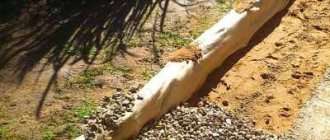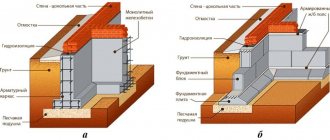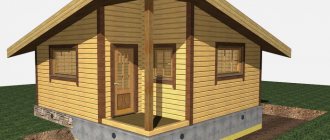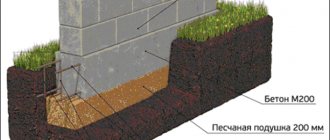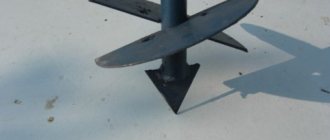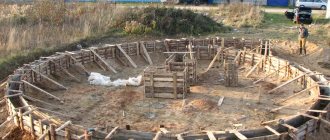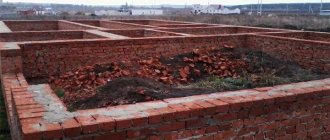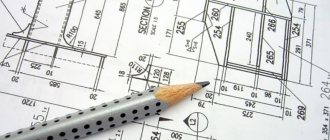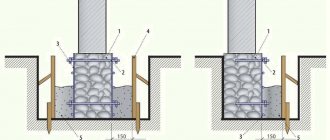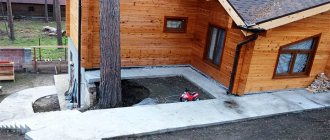Why is it needed?
In general, the foundation cushion for a house is its foundation, laid on the ground before the construction of the main structure. It is formed at the bottom of a pit or trench and is necessary for any type of foundation (strip, slab, columnar).
Main functions and what the pillow is for:
- Leveling the pit surface. It allows you to form a horizontal platform, which is especially important when pouring concrete, because any unevenness and slopes lead to significant waste of material.
- Shock-absorbing function. The cushion takes on both the loads from above from the weight of the entire structure, and the loads from below caused by the movement (swelling) of the soil, reducing them. It distributes the load more evenly.
- Changes in the properties of the top soil layer. The cushion actually replaces it, which is especially important for weak and highly heaving soils.
- Providing drainage. The pillow does not allow moisture to reach the foundation, leaving it inside. In addition, it ensures the removal of sediment and flood water.
The cushion is an essential structural element that reduces the risk of subsidence and deformation of the foundation, smoothes out the negative impact of the soil, making the foundation less susceptible to problematic soils.
Why do you need a pillow under the foundation?
Diagram of the structure of a cushion of one type of foundation.
It is used as an excellent natural waterproofing of the sole and prevents water from entering the subfloor. As a rule, such building elements are not reinforced, except for the pillow block. Why else is it needed:
- It creates a strong and reliable surface under the lower edge of the load-bearing base.
- Blocks groundwater, prevents it from rising above the permissible level, this is the primary layer of waterproofing.
- Provides an even, strong base without subsidence.
- A foundation on a sand cushion is more resistant to soil heaving and is also practically impervious to small seasonal soil movements.
The concrete pad can withstand enormous loads, and if reinforcement is also used, then it can withstand vertical and horizontal seismic shifts of low power.
Kinds
Foundation cushions are designed in accordance with GOSTs and SNiPs. Depending on the materials used, there are several main varieties.
Sandy
Sand effectively absorbs loads and absorbs moisture. With its help, the bottom of a pit can be easily leveled even over a large area. Main advantages: low cost, availability, reduced thermal conductivity, not subject to swelling. This pillow is considered the cheapest option. Disadvantages: subsidence under heavy weight, erosion with a significant volume of water. The use of a sand cushion is limited to one-story buildings. It is not suitable for high groundwater locations.
Crushed stone
The main advantage of crushed stone is increased strength. It is able to withstand heavy loads and distribute them evenly over the entire area. Granite crushed stone has the greatest strength. Disadvantages: the layer allows moisture to pass through itself, and an uneven surface leads to excess consumption of concrete.
Two-component mixture
The question often arises: should I use sand or crushed stone as a cushion under the foundation? The answer is to combine these two materials. The sand-crushed stone (sand-gravel) cushion allows you to use the main advantages of sand and crushed stone (gravel), while compensating for the disadvantages. It has increased strength, allows you to level the surface, and effectively compensates for loads. Such mixtures are most often used in private housing construction.
Concrete
When constructing multi-storey buildings, ensuring high foundation strength comes to the fore. For the construction of strip foundations, special reinforced concrete blocks of the FL brand are widely used. They are made of high-strength concrete with a density of at least 2500 kg/cub.m. Such a pillow can take on enormous loads and compensate for the swelling reaction. The main disadvantages: high cost and the need to use lifting equipment. FL blocks are mainly used in the construction of multi-storey residential and industrial facilities. They are rarely used in private construction.
Sand cushion for the foundation
The choice of the type of cushion is made taking into account the purpose of the structure, its weight and size, the composition and behavior of the soil, and the level of groundwater.
Anti-heaving
Heaving soils create a big problem for the foundation. They differ in that when they freeze, they expand by more than 1%, which creates significant extrusion loads. Such soils include clays, loams and sandy loams, the pores of which reliably retain water, which expands when frozen.
On heaving soils, the replacement function of the cushion is especially necessary . It must be formed from non-foaming materials. Recommendations for the creation of anti-heaving pillows are contained in SP 50-101-2004 and VSN 29-85. Their main task is to replace heaving soil with non-heaving soil at the base of the foundation.
VSN 29-85 (clause 3.3) allows the use for these purposes of a mixture of coarse and medium sand, fine crushed stone and boiler slag. Typically the layer thickness is 30-40 cm. It is important to prevent clay content in the pillow components.
Main characteristics
The main document regulating the production, acceptance and use of these structures is GOST 13580 85. When creating a building drawing, some restrictions are taken into account. The guest note on foundation pillows states that:
- The level of calculated seismicity in the region where they plan to use it is acceptable at 9 points.
- Groundwater or soil may contain chemical components that have a destructive effect on the structure of concrete.
- The use of concrete pads at temperatures below 40°C is permitted if additional measures have been taken to protect them.
Foundation cushions of reinforced concrete products, manufactured in accordance with the state standard, are distinguished by a trapezoidal cross-section. The upper part is narrower; the foundation walls rest on it, for example, under FBS blocks.
When installing blocks on the foundation slab, it is advisable to ensure that the vertical seams are tied. Displacement of elements by no more than 250 mm is permissible.
When purchasing products for a foundation slab, you need to check whether they meet the requirements:
- The class of concrete slabs should be B10-B25, where the last value is the maximum.
- For the manufacture of the reinforcing mesh, steel of classes A400 and Bpl was used.
- Each product has mounting loops located in accordance with the state standard.
- The dimensions of FL pillows can deviate from the norm by no more than 5-10 mm.
- When the blocks are shipped from the factory, it is important that the concrete strength has already reached 70%.
The load-bearing capacity of products is also taken into account. If necessary, the exact value can be provided by the manufacturer.
You cannot do without these blocks if:
- It is necessary to create a large structure with an extensive basement.
- The density of load-bearing walls is at a high level. The pillow is installed under heavy foundation blocks.
- If the house contains reinforced concrete partitions of large size and weight and reliable support for them is necessary.
The production of all blocks should be carried out only using high-quality concrete.
After production, pillows undergo technical control. To check the characteristics, laboratory and visual control methods are used. Perform spot checks of surface categories, measure width and accuracy. They also inspect how correctly the marking is applied, whether there are embedded elements and safety eyelets.
Inspection is carried out to check the dimensions, strength, presence of a protection layer, condition of the fittings and embedded parts, and water resistance.
Manufacturers of foundation cushions of the reinforced concrete series apply markings. It encodes the dimensions, maximum permissible pressure and humidity level.
Which sand to choose?
Backfilling of the sand cushion is carried out in accordance with SNiP 52-01, SP 50-101-2004 and SP 52-101-2013 . The choice of sand is determined by the tasks assigned to this layer.
First of all, it is needed to create a non-heaving layer, and therefore should not contain clay impurities. In addition, dust and fine-grained fractions are easily washed out and migrate into the soil, which also does not allow use as a cushion.
When choosing sand by origin, the following nuances should be taken into account:
- Quarry sand contains uncontrolled amounts of stones and clay. It can only be used after thorough sifting and washing.
- River sand is most naturally purified from impurities.
- Sea sand requires double processing - removal of impurities and hydromechanical cleaning. After processing, it is recognized as one of the best materials.
- Crushed sand. It has an increased cost because... made by grinding rocks. At the same time, it has the greatest strength.
In terms of structure, medium- and coarse-grained sand in accordance with GOST 8736-93 is most suitable for the foundation cushion. The grain size can be in the range of 0.3-2 mm, and the density can be 2.0-2.7 g/cc.
A sand cushion is poured into the bottom of the trench (pit) 20-50 cm thick . depending on the structure of the soil, depth of the foundation and humidity.
A mandatory requirement is thorough compaction of the layer. To do this, backfilling is carried out in layers of 10-12 cm, poured with water and compacted. It is advisable to use a vibrating tool.
Most often the cushion is made from sand-crushed stone or sand-gravel mixture . It uses crushed stone (gravel) of small and medium fractions up to 5-6 mm in size.
What types of foundation pillows are there?
Block base on a sand cushion
Considering that the structure of any cushion under the foundation is approximately the same, there are several types of them, which differ in design and filling material:
- Sand cushion for the foundation. It is made from sifted river sand, and fine gravel can also be used as filling. This pillow has a thickness of 25-30 cm, is additionally moistened with water and compacted.
- Crushed stone cushion for foundations. It is distinguished by its massiveness, thickness and design, because it is made from medium and fine crushed stone, and sand is used as a filter.
- Concrete pad for the foundation. Here, ready-made concrete blocks are used, placed directly on the bottom of the trench or pit. All blocks are connected to each other by reinforcement, concrete mortar and are additionally covered with waterproofing on both sides. As a rule, such a foundation cushion is more practiced for massive large buildings, because it is heavy and the thickness is calculated individually in each case.
It is also possible to provide for the reinforcement of the pillow and the foundation at the same time, and this will further increase the strength of such a structure.
Dimensions: width, height, thickness
In order for the pillow to satisfy all the requirements, it is necessary to choose its dimensions correctly - width, length, thickness. They depend on the structure of the cushion itself, the load-bearing capacity and heaving of the soil, the type of foundation and the massiveness of the structure.
The width and length of the pillow is determined by the dimensions of the foundation . In the case of a strip foundation, backfilling is carried out along the entire length of the trench, and the width of the strip should exceed the thickness of the foundation strip by at least 7-10 cm on each side. The minimum permissible backfill width is 25 mm.
When a slab foundation is erected, a cushion is formed over the entire area of the bottom of the pit. Its dimensions should exceed the dimensions of the slab by 15-20 cm in all directions. For columnar supports, the size of the pillow exceeds the base of the column by 20-25 cm.
The correct choice of the thickness of the compensation cushion is especially important when planning a shallow strip foundation. It is laid above the freezing depth of the soil, and therefore reacts most noticeably to heaving.
The following proportions are used in the calculation:
- with a concrete tape width of up to 65 mm - Н=1.2В (where Н is the thickness of the cushion, В is the width of the tape);
- with a foundation width in the range of 70-95 mm - H=1.15V;
- with a width of up to 100-125 mm - H = 1.1V.
When the width of the concrete strip is over 125 mm, it is considered that there is no need for a compensation layer. The pillow is filled only to level the surface and with a drainage function. In this case, it is enough to have a layer of 25-40 cm.
Based on these recommendations, then with a foundation width of 50 cm, a pillow 60 cm thick is required . It is this thickness that will provide reliable protection against swelling. In this case, the pillow is usually made of a sand-crushed stone mixture. The sand content in it must be at least 30%.
Device
The foundation pillow has a fairly simple design, which makes it possible to make it yourself. You can consider a typical scheme of a full-fledged, combined cushion, which is suitable for fairly heavy structures and weak soils.
The manufacturing technology is described by the following diagram:
- Digging a trench (pit).
- Leveling and compacting the surface layer of soil at the bottom of the trench. This creates a dense base.
- Laying geotextiles. This fabric does not disrupt the circulation of moisture, but prevents sand from migrating into the ground (washing out).
- Backfilling the sand layer with coarse-grained quartz sand. It is covered in layers with moistening and compaction. The minimum thickness of the sand layer is 20-25 cm.
- Filling with crushed stone or gravel up to 5 mm in size. The thickness of the layer is 15-20 cm. This element of the pillow increases strength and increases resistance to crushing. The layer is carefully compacted.
- Laying waterproofing. It is made of roofing felt or thick polymer film. Waterproofing should cover the entire surface of the pillow without gaps. An overlap of about 15-20 cm is provided at the joints.
When making a slab foundation, it is recommended to strengthen the cushion with an additional element - concrete preparation or footing. It not only increases the reliability of the base, but also helps reduce the consumption of mortar during the main pouring of concrete. The footing is made by pouring the so-called “lean” mortar from low-class concrete (up to B12.5).
How to fill?
The solution is poured directly onto the crushed stone layer after it has been compacted . The thickness of the concrete preparation is 6-8 cm. After pouring, a period of 15-20 days is required for complete hardening of the material. Then waterproofing is applied to it.
An important stage in the manufacture of a pillow, which should not be forgotten, is leveling it horizontally and controlling horizontality.
It must be taken into account that even a slight slope in any direction leads to a significant overconsumption of concrete during the main pour and an increase in the cost of the foundation. Horizontal control is carried out using a building level.
